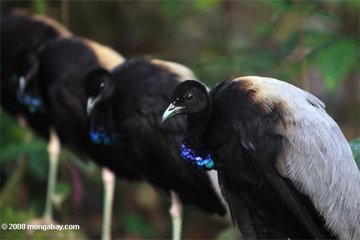Study redraws family tree of birds
Study redraws family tree of birds
mongabay.com
June 26, 2008
|
|
The largest-ever study of bird genetics has rewritten avian taxonomy. The work is published in this week’s issue of Science
The research, based on genetic analysis of 169 bird species over the course of five years, produced some unexpected conclusions about relationships in the bird family tree. The relevations will prompt scientists to change the Latin names of dozens of bird species.
“With this study, we learned two major things,” said Sushma Reddy, one of the lead authors of the study and a researcher at The Field Museum in Chicago. “First, appearances can be deceiving. Birds that look or act similar are not necessarily related. Second, much of bird classification and conventional wisdom on the evolutionary relationships of birds is wrong.”
“This paper makes tremendous strides toward determining the evolutionary relationships of the major branches in the bird family tree,” added co-author Chris Witt of the University of New Mexico. “It uses DNA sequences to infer key events in the diversification of birds that happened tens of millions of years ago.”
 Gray-winged Trumpeters (Psophia crepitans) in the Amazon |
Among the findings from the Early Bird Project: colorful, daytime hummingbirds evolved from drab nocturnal nightjars; falcons are not closely related to hawks and eagles; and tropicbirds (white, swift-flying ocean birds) are not closely related to pelicans and other waterbirds.
The research also undermines the theory that shorebirds gave rise to all modern birds and shows that birds have adapted to the diverse environments several distinct times.
Birds have a complex evolutionary history due to a rapid radiation that occurred over a few-million-year period sometime between 65 million and 100 million years ago.
“The result of this rapid divergence early in the evolutionary history of birds is the fact that many groups of similar-looking birds (for example, owls, parrots and doves) have few, if any, living intermediary forms linking them to other well-defined groups of birds,” explained a statement from The Field Museum. “This makes it very difficult to determine how some of these groups are evolutionarily related.”
The researchers say the new study will help explain this history.
“We now have a robust evolutionary tree from which to study the evolution of birds and all their interesting features that have fascinated so many scientists and amateurs for centuries,” Reddy said. “Birds exhibit substantial diversity (largest of the tetrapod groups), and using this ‘family tree’ we can begin to understand how this diversity originated as well as how different bird groups are interrelated.”
S.J. Hackett et al. (2008). A Phylogenomic Study of Birds Reveals Their Evolutionary History. Science 27 June 2008.